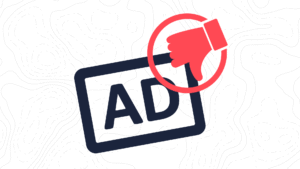A lot of businesses as they get started are looking for tips for Facebook Advertising and we are here to help! Most likely the majority of your growth so far has come from word-of-mouth advertising. You’re offering a quality product or service, so people are eating it up and telling their friends. Because of this, you’ve increased your capacity to do work and now need to bring in even more business through advertising on Facebook. You know that Facebook is the best place for you to be but you’re just not sure where to start. Let us give you a hand!
Facebook is hands down one of the easiest and most versatile places for your small business to begin advertising. Your budget can be as small as $5 a day. Facebook makes targeting specific people based on age, gender, location, stage of life, and affinity super easy too. They also make it easy for you to repurpose the content you’re already posting as an advertisement.
Here’s a quick rundown on some of the advertising options that Facebook offers and when to use them:
Facebook Advertising by Boosting a Post
If you’ve created a Facebook business page, then chances are you’ve seen the blue boost button in the corner of your posts. A boost is the most basic way to advertise your business or organization on Facebook. It simply takes a post that you’ve made on your page, and “boosts” it or promotes it to an audience that you choose. This is especially great when you don’t have a ton of time to create content for and curate a more complete ad.
Boosts allow you to choose a marketing goal, a call to action button, select your audience, and set your budget and duration. The system is very straightforward and difficult to mess up. It is great for getting your social media content out to more people than just your organic audience and even allows you to grow that audience in the process.
Obviously, by promoting your posts outside of your current audience there’s a chance people will see it and go like your page, but there’s also a more direct way that boosts allow you to grow an audience. When you boost a post, if you choose engagement as your marketing goal, it will show your post to people who are most likely to like, comment or share it. When your boost duration is over, go back to the post and click on the number of likes in the bottom left-hand corner. This will bring up a list of everyone who liked your post and then gives you the option to invite them to like your page. It’s an easy win!
If you find yourself with limited knowledge of online advertising, limited time to do it in, or with stellar content that you want more people to have the opportunity to see, boosting is the place for you!
Pros of Boosting
- The simplest way to advertise on Facebook
- Doesn’t require additional content
- Provides a simple way to grow an audience
- Takes very little time
- Is self-contained (no need to check on it continuously or remember to turn it off)
Cons of Boosting
- Limited customization
- Goes out of date quickly
- Limited ad placements
Facebook Ad Campaigns
Facebook ads are where things get complicated but also really fun. Facebook Ads are lumped into three major categories with sub-objectives beneath each one. The three overarching categories are awareness, consideration, and conversion.
Awareness Ads
Awareness ads are those that help bring your business/organization to the attention of your relevant audience. There are two different subsets of ads within this category: brand awareness and reach. These two objectives are similar but have one key difference.
With brand awareness ads, the goal is to place the ad in front of people who are most likely to remember it when asked within two days about it. This means that the same people might be seeing your ad multiple times, but the hope is that by seeing it more frequently they’ll be able to recall it later on. This metric is called ad recall lift. Reach ads however aren’t as concerned with selecting the people who are most likely to remember seeing your ad. Instead, reach ads take more of a “cast your net wide” approach and show your ad to as many people as possible in the hopes that for some percentage of those people it sticks.
These ads are particularly useful for new businesses, businesses trying to break into a new market, and businesses using online marketing for the first time. I typically suggest that a business start out with a brand awareness campaign for a minimum of 3 months, but preferably for 6 months. You can obviously run other ads on top of these, but getting your business to be a “household name” is key.
Consideration Ads
Consideration ads are used to grow audience knowledge and engagement with your business by going to your website, downloading an app, liking your page, etc. The subsets within this category include traffic, engagement, app install, video views, lead generation, and messages.
Traffic ads are used to drive users to your website, app, or event. Facebook shows your ad to the people who are most likely to click and visit.
Engagement ads are used to encourage people to like, comment on, or share your content, like your page, or respond to an event. This particular type of ad is one that we use a lot to help businesses build their online audience. The like campaign is incredibly helpful for growing your audience so that later on your organic reach is also increased. You can also use this type of ad to encourage interaction through comments and likes.
App Install ads are exactly what they sound like, they encourage people to download and use your app. This is especially useful for places like boutiques or other stores that utilize apps to make online sales.
Video Views ads are useful in getting people to learn more about you or your business. Consider this like a commercial where you can go into more depth about the value of your business or organization than you could in a short written ad.
Then you have lead generation ads. These ads are helpful in garnishing contact information from your desired audience. You can lead them to a contact form, chatbot, or simply to your phone number. This allows you to collect information and then reach out to them, later on, to see if they are a good fit to work with your company.
Last but certainly not least there are messaging ads that specifically encourage people to shoot you a message on Facebook. These ads can be useful if you have someone regularly checking and responding to your inbox, but if you don’t then they can cause a lot of frustration for a potential client or customer.
Conversion Ads
The last type of ad objective is conversion. Conversion ads are those that lead people to make a purchase or complete an action on your website, your catalog on Facebook, or in your physical location. While it might seem like conversion ads are the way to go since making more money is always a good thing, they aren’t always the best option, and jumping into them without setting the groundwork can be futile. There are three specific subsets of ads in this category: conversions, catalog sales, and store traffic.
Conversion ads are those that are shown to people most likely to make a purchase or complete some other kind of action on your website. This of course is beneficial if people are completing their purchases while on your website and not just beginning the process.
The second type of conversion ad is catalog sales. These are very similar to conversion ads, except they send people to your online catalog that is housed within Facebook’s commerce manager to make a purchase instead of your website.
Lastly, there are store traffic ads that are used to target people who are most likely to visit your store when they are in the area. This type of ad is the most difficult to track success because you would have to find out from each person who visits where they heard about you. However, if you’re looking to increase foot traffic they can still be beneficial.
Just remember, before starting conversion ads, make sure you’ve put in the effort to create a foundation with other types of ads so that your conversion ads are the most effective.
Pros of Facebook Ads:
- Extremely Customizable
- Can be ongoing or scheduled
- Multiple Placements (Stories, Timeline, Instagram, Messenger etc.)
- Budget Friendly Advertising
- Easy to read metrics
Cons of Facebook Ads:
- More complicated to create than Boosts
- Requires additional assets
- Can feel overwhelming at first
Facebook’s New Ad Experience
Facebook is constantly changing and evolving and those changes are typically rolled out in several waves to gauge audience satisfaction and get feedback. One such change just recently started rolling out in the Facebook Ads Creator. So, if you were reading this article and thinking that your ads manager looks nothing like what is described above, chances are, you’re on the new ads experience. Lucky you!
The social media giant says the new update should make running ads simpler and more streamlined for the average user. They also claim that all the same functionality is still possible with the new setup. The biggest difference is that instead of three main categories with eleven sub-categories there are now just six ad objectives to choose from with more detailed targeting taking place within the ad set itself. The six categories are awareness, traffic, engagement, leads, app promotion, and sales.
For example, if you wanted to create a like campaign, instead of clicking on engagement and then page likes, you’ll simply choose the engagement ad objective and then tell within the Ad Set that you’d like that engagement to take place on your Facebook page as opposed to your post, in messenger, etc.
If you’re looking to begin advertising your business online, Facebook is one of the quickest and easiest places to start, even with all the changes. Not to mention, with 2.85 billion users, Facebook is still the world’s largest social media platform. That means that your audience is practically guaranteed to be present and just waiting to learn about you and your business. If you need consulting help when it comes to your ads or you’d rather leave the marketing to the professionals, give us a call! We’d love to hear from you.


